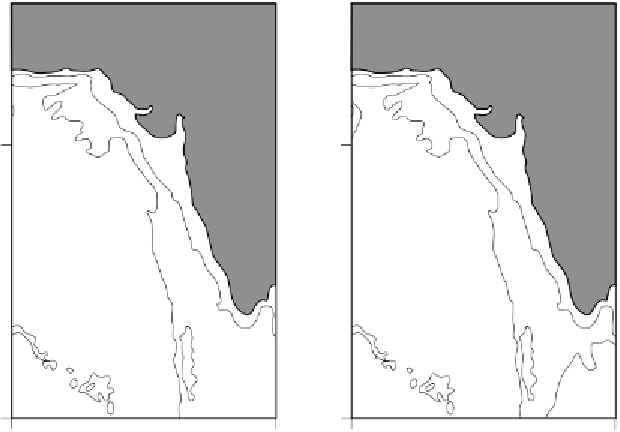Environmental Engineering Reference
In-Depth Information
PAKISTAN
PAKISTAN
INDIA
INDIA
Karachi
Karachi
20˚
N
20˚
N
Mumbai
Mumbai
Goa
Karwar
Mangalore
Goa
Karwar
Mangalore
Cochin
Arabian Sea
Arabian Sea
Cochin
LL
SMC
LH
NMC
(b)
(a)
0˚
60˚
0˚
60˚
E
80˚
80˚
E
Figure 1.
Major features of surface circulation in the eastern Arabian Sea during (a) Northeast
Monsoon, and (b) Southwest Monsoon (RHJ - Ras-al-Hadd Jet; WICC - West India Coastal
Current; LH - Lakshadweep High; LL - Lakshadweep Low; NMC - Northeast Monsoon
Current; SMC - Southwest Monsoon Current) (modified from [48]).
create a lighter (warmer and fresher) water mass that floats over the cold, saline
upwelled water, generally preventing the latter from surfacing [4, 38].
Despite lighter winds during the winter or northeast monsoon (NEM,
December-March) it is, paradoxically, during this season that coastal circulation off
India is the best organized (Fig. 1a). The LL is replaced by the Lakshadweep
High (LH), an anticyclonic eddy. The now poleward-flowing WICC is not only
better developed and stronger (transporting approximately 10 Sv of water off
the southwest coast of India), it also flows against the wind [51], underscoring
the importance of remote forcing [32]. This flow greatly influences biogeo-
chemistry because it induces downwelling over the Indian shelf and brings
waters from low latitudes, which are nutrient-impoverished. Moreover, its low
density does not permit the development of the convective mixing regime (with
elevated nutrient levels) that occurs elsewhere in the Arabian Sea at comparable
latitudes (e.g. as far south as off Somalia [55]).
The effects of seasonal changes in circulation on the hydrographic structure
and biogeochemical cycling extend beyond the continental margin [41]. During
the SWM, when the surface flow is directed toward the equator, the subsurface
current moves in the opposite direction [3,52]. The West India Undercurrent




